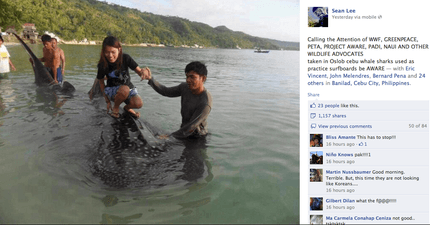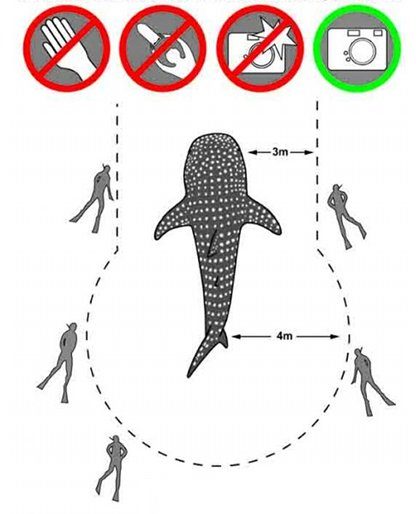SUMMARY
This is AI generated summarization, which may have errors. For context, always refer to the full article.
MANILA, Philippines – If you’ve checked your Facebook account on April 1, Sunday, chances are you’ve seen the widely-circulated photo of a woman trying to surf on top of a whale shark, or more locally known as butanding.

Cebu-based Sean Lee shared this photo on his Facebook wall, adding that it was taken at a beach in Oslob, a town in Cebu that is gaining prominence among tourists for its butanding sightings.
Another photo, this time with a bigger crowd gathering near the whale shark, would follow and also appear in Facebook.

These photos went viral hours after they were posted online, eliciting expressions of concern and alarm.
Other comments towards the end of the day, including those from Cebu-based Facebook user Nix Cue Nicolas of Save Philippine Seas, would later reveal that these actually happened in the town of Boljoon, just north of Oslob, and that the shark in both photos was reportedly just stranded near the shores of the town.

Rappler tried to reach the local government, tourism officials, and the BFAR officials for comment, but none came as of posting.
Regardless of the incorrect identification of place, these photos has generated a lot of negative feedback from various Facebook users. People would claim that there was indeed a violation of an important rule in tourism: never touch or go near these giant species.
The photo has opened up a discourse that butandings should be treated properly, especially in areas where tourists get up-close and swim with these creatures.
Unfortunately, a violation like that in the photos really persists.
Just in Oslob, a news item has reported that residents complain about tourists not really paying attention to the rules. The rules usually violated are:
- no flash when taking photos of the whales
- no touching the whale sharks
- no riding on the animals
Even Donsol in Sorsogon, probably the most famous of all butanding sighting spots, is not spared of this problem. A report revealed that some tourists really touch the whale sharks, and some get too close to the animals for photos.
All these happen despite the tourists being given a briefing of some do’s and dont’s before heading to the waters with the whale sharks. These guidelines include the following:
- do not touch or ride the whale shark
- do not restrict the movement of the whale shark, or impede its natural path
- maintain a distance of 3 meters from the head or body of the whale shark, and 4 meters from its tail
- do not use flash photography
- a maximum of 6 swimmers per whale shark is allowed, and only 1 boat per whale shark.

“A lot of people either don’t know or they don’t care. And that’s a problem,” stressed Lory Tan, vice president and CEO of the World Wide Fund for Nature (WWF) in the Philippines.
Tan said in a phone interview with Rappler that these violations committed by tourists could actually constitute as crime. “It’s absolutely wrong. They should be put in jail if they violate the rules. Ignorance is not an excuse,” he said. – Rappler.com
Add a comment
How does this make you feel?





There are no comments yet. Add your comment to start the conversation.